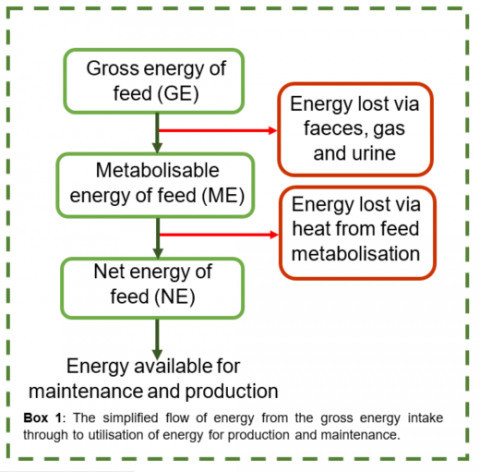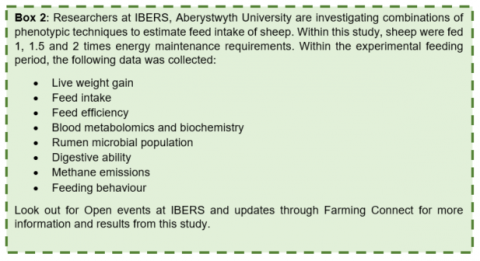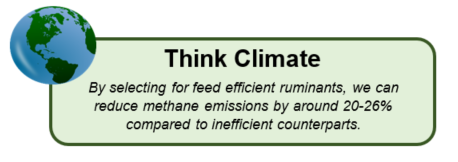Dr Ruth Wonfor: IBERS, Aberystwyth University
Take home messages:
- A feed efficient animal will eat less whilst maintaining production and health and emitting less methane.
- Feed efficiency in ruminants is linked to the microbial population in the rumen, but there is also an animal effect, which can be selected for in breeding programmes.
- Although genetic tools are being developed for detection of feed efficiency, a phenotypic method would be useful for easy detection on-farm. Current research is working to establish such a method.
To increase livestock production to meet growing food demands, whilst also reducing the environmental impacts of livestock systems, we must strive towards more efficient systems. For many years, we have selected our animals to be better producers – growing at a faster rate and to larger sizes, producing greater volumes of milk or meat. Many production systems have now also realised that selection needs to include health of the animal. Over recent years, there has been a push in the dairy industry towards improving fertility of the animals. Furthermore, selection for animals resistant to certain diseases has received considerable attention as an option for improved disease management and reducing the need for at risk treatments, such as antibiotics. More recently, industry and research has focussed on how we can select ruminants to process their feed more efficiently. Such selection will result in maintaining a high production level from less food, and emitting less waste products, reducing the environmental impact of ruminant products. A recent technical article has focussed on feeding less protein to dairy cattle to reduce nitrogen emissions, whilst still maintaining production. However, there is an abundance of literature and research that is trying to improve the energy conversion of feed in the animal, primarily through their genetic potential for feed efficiency (FE). It is estimated that through lowering the feed intake of efficient bulls, whilst maintaining production, a saving of 387 kg of feed dry matter per head can be made annually. Not only is this beneficial economically, saving on feed needing to be bought in, but also on a global scale, reducing competition for land and grain for human consumption. Improving FE not only means that animals need to intake less feed to be as productive as their unselected counterpart, but also that they will produce less methane, a potent greenhouse gas produced by ruminal feed fermentation, a process essential in ruminant digestion.
Essentially, FE is a trait for how well the animal utilises the energy from feed towards production. Box 1 outlines a simplified flow of energy in the animal from the gross energy intake of a feed to the end point of utilisation of this energy into maintenance and production. Feed efficiency is a complex trait and therefore can be difficult to measure. Residual feed intake (RFI) is the commonly used measure of FE, due to its independence of the level of production. Residual feed intake is defined as the actual versus predicted intake of an animal based on its size – essentially, how well gross energy (GE) of a feed is converted into net energy (NE; see Box 1). An animal that has a high FE will have a low RFI, and vice versa. Recent research has demonstrated that low RFI beef heifers intake 6% less feed than high RFI heifers. Such animals are likely to have a greater digestive ability; quite simply, they are able to utilise more of the energy from feed rather than partitioning greater amounts to be lost through faeces.
The type of diet fed can have an impact on the FE of the animal. In feeding energy dense and easily digestible diets, the efficiency of conversion of GE to NE can be improved. Yet to attain this, we need to feed ruminants diets comprised of high starch, in the form of grains and fats. This is unattainable both profitably and sustainably. Thus, if possible, it seems logical to improve efficiency through FE of the animal itself.
Residual feed intake is difficult to measure on-farm as the dry matter intake (DMI) of each animal must be accurately assessed. Although this is practical in scientific research, the ability to calculate RFI accurately for each animal in a herd or flock, especially if out at pasture, is impractical. Therefore a proxy measure must be developed that can be used in practice, whether that be a genetic estimated breeding value (GEBV) or phenotypic trait. However, to be able to do this we must first understand the biology of the animal as to what causes this variance in FE.
Rumen microbiome
The microbial population, or microbiome, of the digestive tract is essential for the host’s digestive capacity and physiology. This symbiotic relationship is particularly important in ruminants, who require the microbial population in the rumen to help breakdown their natural diet.
The microbiome of the rumen is divergent between cattle, thus it seems logical that some microbiomes may be more efficient than others. Indeed, studies have found that the microbial profile of the rumen is associated with RFI in cattle. Yet this association is modulated by the diet, only cattle fed a high fibre diet were identified to have clear differences in their ruminal microbiome on comparison of high and low RFI animals. As well as diet, there are other variables which can affect the ruminal microbiome, including host age, species, health and antibiotic use, amongst others.
Within the ruminal microbiome, there is a subset of microorganisms that produce methane, called methanogens. Methane production is associated with inefficiency, as its production in the rumen requires energy. Thus, more efficient animals utilise less energy for methanogenesis subsequently resulting in these animals emitting 20-26% less methane than their inefficient counterparts. Research has therefore investigated whether differences in the methanogen population in the rumen are linked to FE. It is demonstrated that inefficient cattle have a less diverse population of methanogens.
From ruminant microbiome research, the question arises whether the microbiome is dependent on animal physiology and therefore whether the genetics of the cow itself control the ruminal microbial population. Indeed, research has demonstrated a high level of host specificity for the microbial community. Such work could relate back to the digestive ability of the animal. A recent study found that digestive ability accounted for up to 31% of RFI variation in dairy cattle when fed a high fibre diet, but had no effect in high starch diets. Further research needs to be completed to investigate if this is linked to the microbial population in the rumen.
Genetics
Based on the fact that there is an animal effect on FE, the genetics of FE in the animal have been examined. Through analysis of 4,900 cows in three different countries, heritability for RFI is estimated at around 0.17. At present, it appears that RFI is a relatively stable trait and so is appropriate for use as a selection tool. With the development of genomic selection based on SNP markers related to FE, the selection of the trait can be strengthened in practice. Research has now developed a GEBV for RFI in Holstein-Friesian cattle.
Care must be taken when utilising RFI in breeding programmes. It must always be remembered that this is one aspect of an animal’s efficiency. Production efficiency must be remembered, whether that be meat or milk, as well as fertility and health. Each parameter must be developed into a breeding goal for the flock or herd. A benefit of selecting for RFI is that it is not genetically linked to production or body weight, unlike DMI. Yet, some research has reported better fertility in animals with higher RFI and therefore lower FE.
Alternative measures to predict intake
Phenotypic measurements are also useful selection tools in a breeding programme. The main phenotypic predictors of FE discussed in this article are RFI and methane emissions, yet both of these are difficult to measure in practice. A current five-year InnovateUK funded project is working to develop estimated breeding values for Stabiliser cattle based on net feed efficiency. To be able to establish net FE the project involves accurately measuring feed intake and live weight gain in individual cattle. Yet such measurements requires a research like set up, with accurate feed intake technology that is not commonplace on-farm.
Researchers are working to develop an easy to use phenotypic tool to identify feed efficient animals. Work has focussed around biomarkers, emissions and behaviours. For example, heifers with higher FE are shown to feed for a longer period of time. Ideally, research should look at potential phenotypic tools and relate this back to the biology of FE in the animal. Work in IBERS, Aberystwyth University is doing just this. The project is looking to evaluate existing methodologies for estimation of intake in sheep and relate increasing levels of intake back to the rumen microbiome. Research in FE has so far primarily focussed on cattle, and so the study at IBERS is much needed for the sheep industry. Box 2 outlines some of the data being recorded in this study. Look out for future events held by Farming Connect at IBERS, which will highlight some of the results to date in this project.
Feed efficiency of ruminants is going to be an essential area to focus on in the future, both economically and environmentally. Through selecting animals that eat less whilst maintaining production and health, we will be breeding animals in the future that can better partition energy towards production and reduce methane emissions. Yet research needs to carry on in this area to identify markers for FE, which are easy to record on-farm. Such work will make selection for FE more attainable at farm level, thus making it easy to include as a breeding objective in ruminant systems.



